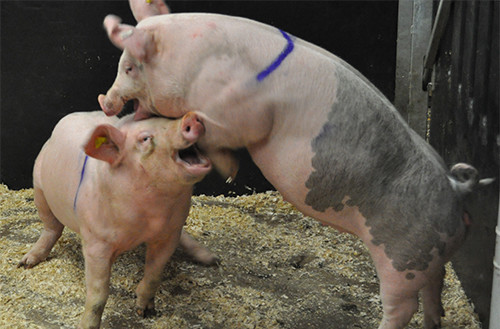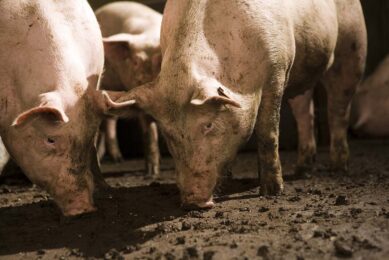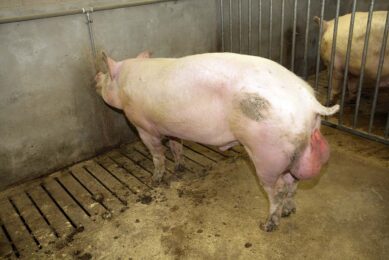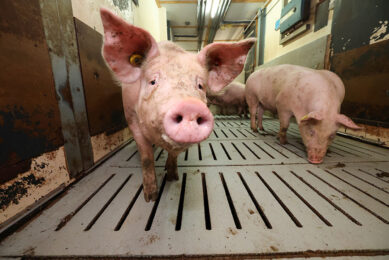Why avoid aggression between pigs?

When unfamiliar pigs are grouped together they fight to establish dominance relationships. This natural behaviour can, under farm conditions, escalate to the extent where health and productivity are affected. Aggression increases stress, causes skin lesions and can result in injury and reduced immunity and growth.
Aggression has been researched for several decades but remains undiminished at most farms. Regrouping unfamiliar pigs into a new pen, which causes aggression, is often unavoidable within the current housing systems. Avoiding regrouping therefore often means less optimal use of pen space.
Solutions other than building modification are only partially effective. Researchers at Scotland’s Rural College (SRUC, formerly SAC) in Edinburgh, UK have been working on pig aggression for over 15 years. Recently, an information leaflet on aggression has been made available for farmers. This article contains its highlights.
Effects on production
Aggression between newly mixed pigs lasts for around 24 hours, after which it reduces but remains heightened for up to three weeks. Aggression results in skin lesions which mostly fade after one or two days.
Recent research from SRUC shows that in the United Kingdom, most farmers don’t see aggression as a problem on their farm. However, effects of aggression may be overlooked. Aggression increases stress, causes skin lesions and can result in injury and reduced immunity and growth. In sows it can lead to abortion. The time spent on fighting comes directly at the cost of the time spent on feeding. Growth rate is therefore most often reduced on the first days after regrouping.
Signs of extreme aggression
Extreme aggression can result in more substantial losses due to lameness, infections and death.
• Newly mixed pigs will show some skin lesions (see pictures). Every lesion is the result of a bite. Patches of lesions can signify around 50-100 bites. This goes together with high levels of exhaustion.
• Aggression should subside around 24 hours after regrouping. Lameness and death at regrouping indicate very extreme aggression (given that flooring is appropriate).
• In stable groups aggression should be minimal. Recently, cases of deaths due to aggression in stable groups seem to be increasing. If repeated issues with this are encountered, kindly contact the author at the SRUC (details below).

When should you take action?
It is advised to take preventative measures to reduce aggression in any case, but especially if extreme aggression occurs. Monitor the occurrences of extreme cases to assess the impact of management changes. Note down pigs with extreme numbers of lesions and monitor them as they have a higher risk of reduced immunity.
Seven tips to reduce aggression
Optimise regrouping
Mixing pigs helps to optimise group formation and allows precision feeding. Disadvantages such as stress, aggression and disease spread can level out the benefits.

Avoid regrouping when possible. If needed, then regroup pigs as young as possible. The older and heavier pigs are, the more likely that growth will be reduced and injuries occur.

Try to keep the number of unfamiliar pigs per pen as low as possible. The higher the familiarity, the fewer the fights. Caution: Do not put one or two unfamiliar pigs in an established group.
Careful selection of sows
Aggressiveness is heritable. Careful selection of the sows can thus reduce aggression in the population.

Score gilts on aggressiveness (e.g. 0 not aggressive – 5 aggressive) and take this score into consideration when selecting replacements.
Co-mingling litters pre-weaning
Co-mingling, or socialisation, involves putting two or more litters together before weaning. This increases pigs’ abilities to resolve dominance relationships quickly with limited long-term aggression.

Let litters co-mingle a few days before weaning (by removing barriers between crates) to reduce stress at weaning.
Pen conditions
When space is limited, pigs cannot properly retreat. Limited space also increases repeated fights between the same pigs, as fights may be interrupted.

Providing plenty of space at mixing allows pigs to establish their hierarchy quickly.

Provide an obstacle behind which a pig can hide its head (e.g. straw bale) as this can substantially reduce injuries.

Enrichment material occupies pigs and keeps them from continued fighting. Caution: items can also be a resource to fight over, increasing aggression.
What does it really cost?
Aggression is known to reduce profits, but the actual costs of aggression are unknown. In a project that started recently, the SRUC calculate the costs and benefits of strategies to reduce aggression, taking account of farmers’ perspectives on aggression and opinions on different strategies. This does however require farm information. Pig farmers all over the world are invited to participate in this study.
Research findings
There is a large variation in the amount of fighting between pigs even within the same population. Little is known about how pigs decide whether to fight or not, and for how long to continue. SRUC researched this over the last three years in over 700 pigs.
The decisions pigs make when it comes to fighting
It was always assumed that pigs would assess the opponent, and decide not to fight or to give up sooner if the opponent was much larger. It has become clear now that pigs fight equally as much even if there is a large weight difference. Only when socialised to other pigs during early life do pigs seem to make this assessment of their opponent. Experience thereby has an important role in reducing aggression.
Boars will fight differently
Entire males and females were compared for their aggressive behaviour. Even though pigs were pre-pubertal, males persistently showed more aggression than females from week ten of age.
Males fought for longer, showed more ritualised display behaviour, and won when fighting against a female. An example of ritualised behaviour is foaming (foam from the mouth), which reflects the motivation to fight. Foaming was almost exclusively seen in males and the occurrence increased with age (see Figure 1).
Figure 1 – Foaming behaviour in entire boars and gilts during an aggressive encounter at 8, 10 and 13 weeks of age in a trial involving 734 pigs.
Novel methods to capture the impact of aggression
Novel methods can give insight into the intensity of aggression. In over 500 aggressive interactions blood glucose and lactate were measured. Changes in heat were recorded using thermal imaging (see Figure 2).
Figure 2 – Thermal image of two pigs in a fight. Infra-red radiation (heat) emitted from the pigsis detected by the imager and converted into a thermogram where colours represent the surface temperature of the skin. In this image, the bitten pig shows a higher surface body temperature (white) than its opponent.

Even in fights of less than 15 minutes, but of high intensity, maximum glucose values were reached, equivalent to those of human competitors in Olympic sports. This shows that considerable effort and energy expenditure is happening even in seemingly mild fights.
In case readers are interested to learn more or to participate in stakeholder meetings, kindly approach the author at Irene.Camerlink@sruc.ac.uk.
 Beheer
Beheer









 WP Admin
WP Admin  Bewerk bericht
Bewerk bericht